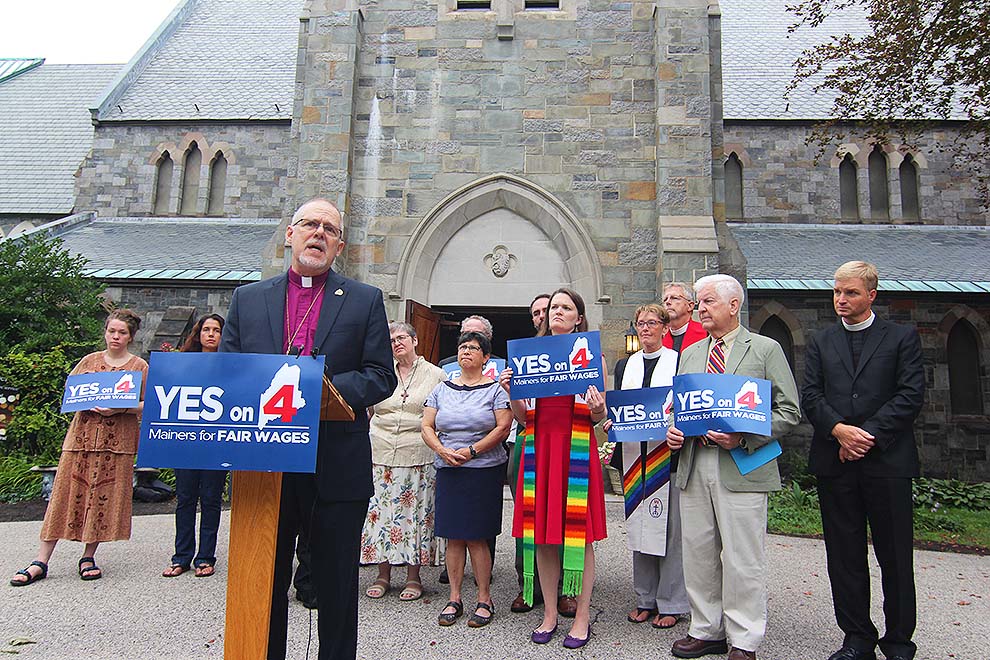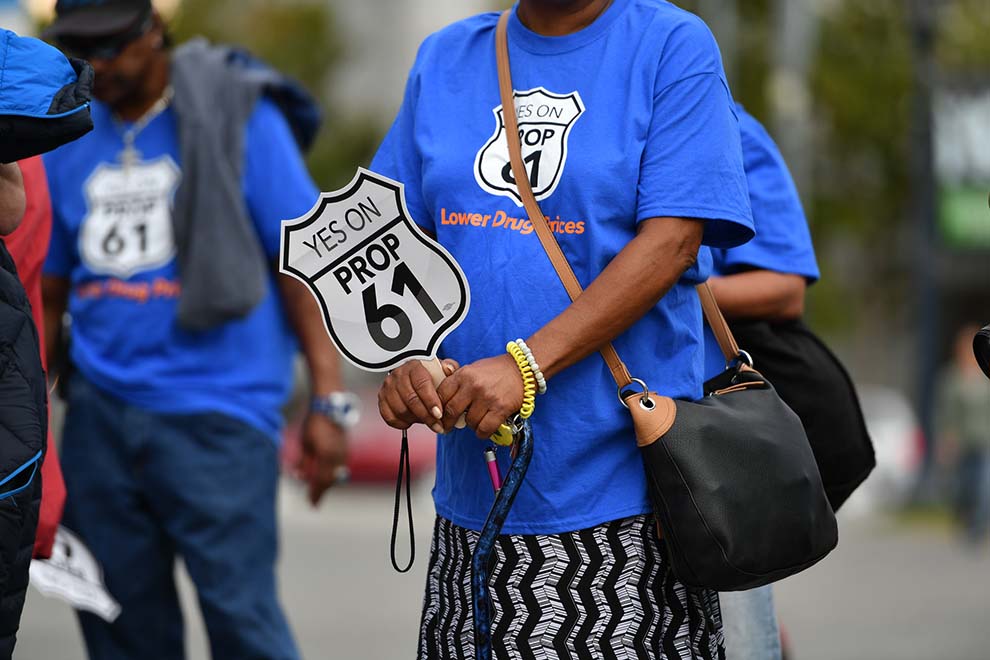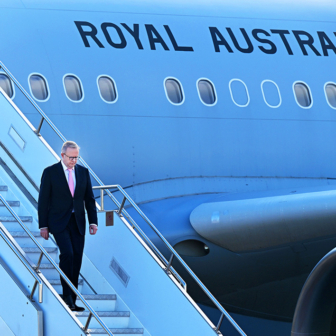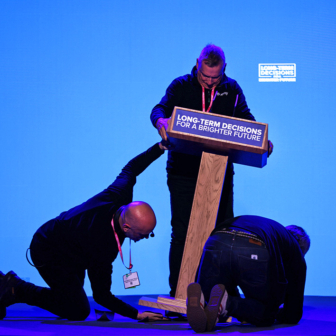We tend to look at the US elections exclusively through the prism of the presidential race. The contest for the White House is a cocktail of conflict, personality and power that’s hard to resist – for journalists and audiences alike. Add the candidacy of Donald J. Trump and it’s perhaps no surprise that the only down-ballot contests that are allowed to share a little of the spotlight are those Senate and House races that will shape what the new president will actually be able to do.
But the reality is that the choice of presidential candidate is just one of many decisions Americans will make when they vote on 8 November. And beyond electing representatives, voters in thirty-five states will also engage in direct law-making: deciding whether or not to approve a total of 163 ballot measures. The success or failure of those measures – on topics as diverse as compulsory condoms in pornographic films, the minimum wage, universal healthcare, campaign finance and repeal of the death penalty – will have an impact on the lives of more than 205 million people.
The contentious question of gun control illustrates how consequential ballot measures can be. In the face of recurring tragedy, measures in Maine and Nevada propose to eliminate the loopholes in background checks for gun purchases. According to Nate Silver’s FiveThirtyEight, at least 70 per cent of Americans want this reform – and it’s not a fleeting sentiment, either. Majority support for universal background checks has been showing up in polling for decades. And yet Congress, swayed by intense pressure from the gun lobby, has refused to yield – or to introduce any other reform that might mitigate gun violence. The measures in Maine and Nevada, on available polling, both look likely to succeed, as did a similar initiative in Washington State in 2014.
Responding to an increasingly urgent debate about inequality in America, Hillary Clinton has committed to increase the federal minimum wage from US$7.25 to US$12. Even in the likely event she wins office, though, it’s unlikely her administration will be able to make much headway on the issue. Unless the Democrats achieve the near-impossible and win back the House as well as the Senate, she will face the insuperable obstacle of unwavering Republican opposition. Low-wage workers are much more likely to win a pay increase as a result of ballot measures than courtesy of Washington. Arizonans will decide whether to increase their state minimum wage to US$10 next year and US$12 by 2020 (along with guaranteeing a right to paid sick leave). Coloradans and Mainers will vote on similar propositions and Washingtonians will decide whether to vote up a minimum wage of US$13.50. Public opinion on these measures – which will, in total, cover 21.6 million American workers – is favourable in every state where they’re on the ballot.

State by state: leaders of ten different faith traditions urging support for the 8 November referendum to raise Maine’s minimum wage. Mainers for Fair Wages
While the ambition of establishing a comprehensive federal public health insurance scheme faded along with Bernie Sanders’s candidacy for the Democratic nomination, single-payer advocates continue to prosecute the case in Colorado. ColoradoCare would provide public health insurance for all residents, funded by a 10 per cent tax on payroll and other income. While the proposed tax hike (and the fact that even Democrats and progressives haven’t unified around the proposal) means the measure is likely to fail, an attempt to expand access to healthcare in another state is proving much more popular.
In California, Proposition 61 would cap prices paid for medicines by government agencies at the same level the US Department of Veteran Affairs does, estimated to be about 41 per cent of market prices. In a recent op-ed in the Los Angeles Times, Bernie Sanders pointed out that while one-in-five working-age Americans can’t afford their prescriptions, the top five pharmaceutical companies made $50 billion in profit last year alone. “How have pharma companies gotten away with such avarice?” he said.
Sanders’s answer is that the companies that make up the industry “currently have 1266 lobbyists on their payrolls in Washington, DC, and 118 fighting for their priorities in Sacramento… And just this year, massive pharma lobbying efforts killed two bills in the heavily Democratic Californian legislature that would have made modest steps toward drug-pricing transparency.”
The lobby is investing just as heavily in trying to stop Prop 61. With a total of US$123.6 million spent by both sides so far, it may turn out to be the most expensive ballot measure campaign in California’s history. Big pharmaceutical companies are spending seven dollars for every dollar spent by supporters of pricing controls. Despite the lopsided campaign spending, though, somewhere between two-thirds and three-quarters of Californians are saying they will vote yes on Proposition 61.
Measures in five states to legalise recreational use of marijuana are also garnering considerable attention this year. Polls suggest that they will succeed in California, Maine and Massachusetts and may get up in Nevada and Arizona as well. If so, a quarter of all Americans will be able to light up legally. Further measures on November’s ballot in Arkansas, Florida, Montana and North Dakota would permit medicinal use only.
Marijuana legalisation well illustrates the power of the ballot measure. Beyond their immediate impact, successful measures become precedents that change debates and, ultimately, the policy landscape. The spate of pro-pot measures this year comes after successful measures in Alaska and Oregon in 2014 and Colorado and Washington State in 2012. California’s second most powerful politician, lieutenant governor Gavin Newsom, told the New York Times, “If we’re successful, it’s the beginning of the end of the war on marijuana... If California moves, it will put more pressure on Mexico and Latin America writ large to reignite a debate on legalization there.”
Americans began embracing direct democracy at the dawn of the twentieth century, in the same surge of Progressive energy that resulted in term limits, popular election of national-level senators, and the right for women to vote.
Reformers saw citizen law-making as a critical tool in challenging the power of big business, particularly in the western United States, where politics was dominated by the all-powerful Southern Pacific Railroad company or, as it has been called, “The Octopus.” Southern Pacific was known to use bribes, threats and its monopoly over transcontinental trade to control elected officials from city councillors all the way to congressmen.
In 1892 a New York journalist, James Sullivan, published a detailed study of the Swiss system of direct democracy, Direct Legislation by the Citizenship through the Initiative and Referendum, based on his travels there. Sullivan argued that “much in proportion as the whole body of citizens take upon themselves the direction of public affairs, the possibilities for political and social parasitism disappear… and the privileges of the monopolist are withdrawn.”
Sullivan’s book was picked up by a budding politician, William U’ren, soon to be elected to the Oregon legislature as a member of the People’s Party. U’ren saw in Sullivan’s prescription of mass popular participation a solution to his state’s ills. When U’ren and the Populists gained the balance of power, they wrangled legislative support for an amendment to the state constitution that introduced the ballot measure as a new means of law-making. The amendment was overwhelmingly endorsed in a referendum – with 92 per cent of voters in favour – in 1902. What became known as “the Oregon system” was born. In 1911 the governor of California, Hiram Johnson (soon to run as a vice-presidential candidate on Teddy Roosevelt’s Progressive ticket) introduced the ballot measure as part of a suite of reforms in that state. By the end of the Great War around two dozen states and numerous counties had adopted the ballot measure.
Ballot measures come in a variety of forms. The ones that most resemble an Australian referendum are legislatively referred constitutional amendments. While these are common, the most substantial measures in policy terms – and the ones that generate the most attention and controversy – are citizen initiatives. Ballotpedia, the wonderfully comprehensive encyclopaedia of American politics, estimates that of the US$744.8 million spent on ballot measure campaigns this cycle, 94 per cent of it has been devoted to supporting or opposing citizen initiatives.
Initiatives either alter statutes, create statutes or amend state constitutions. (Somewhat confusingly, initiated constitutional amendments are often used to change public policy rather than the machinery of government. The ColoradoCare measure is a proposed constitutional amendment; so is a measure to legalise medicinal marijuana in Florida.)
Unlike Australian referendums, citizen initiatives do not require the prior blessing of a legislature. To become law, the initiative first needs to get on the ballot by acquiring a requisite number of supporting signatures. It then needs to win the support of a simple majority of the state’s voters.
Signature requirements are calculated as a percentage of voters who turned out in the previous election. That percentage varies from state to state, but is generally around 5 per cent. Ballotpedia attributes the high number of citizen initiatives this year (seventy-two compared to thirty-five in 2014 and fifty in 2012) to low voter turnout in 2014. Whereas more than 500,000 signatures were required to get an initiative on the ballot in California in 2014, only 365,880 signatures were needed this year. That trend is constant across most states.
Still, getting that number of signatures is no mean feat. And the task is complicated in some states by an additional minimum percentage requirement for every individual county. In 2016 over 900 initiatives were filed with state authorities, more than ten times the number that made the ballot.
To succeed, petition drives need serious energy, organisation and money. Ballotpedia calculates that, on average, getting an initiative onto the ballot this year cost more than a million dollars, and the average cost-per-required-signature was US$5.51. Much of that money is spent on buttressing volunteer effort with paid petition-gatherers.
Then the campaign to win at the ballot begins. Initiative campaigns aren’t easy, but successes in the United States are a lot more common than successful referendums in Australia. There have been over 2000 statewide ballot initiatives in the United States over the same period that Australia has witnessed forty-four referendums. While the Yes vote has won in just eight of our referendums, over 800 ballot initiatives (around 40 per cent) have succeeded.
As well as creating law, citizen-initiated measures can also function to veto laws that have been passed by the legislature. There are five such veto referendums this year. In one case, some South Dakotans are seeking to overturn a youth wage of US$7.50 an hour created by the Republican-dominated legislature. The youth wage is, in turn, an attempt to undermine a successful 2014 initiative in South Dakota to lift the minimum wage to US$8.50 an hour.
Three advisory questions, similar in effect to Australian plebiscites, are on ballots in November. The most prominent, Proposition 59 in California, encourages elected officials to do all they can to overturn Citizens United, the Supreme Court decision that struck down constraints on money in politics.
Citizens in numerous states also have the power to recall elected officials. While that power is not being exercised in November, the campaign to recall Aaron Persky, the judge who gave a remarkably light sentence to Stanford rapist, Brock Turner, is in full petition-gathering mode. That campaign aims to have a recall measure on the ballot in Santa Clara County, California, next November.
It all sounds positive and democratic, but not everyone thinks so. In a recent conversation with Vox’s Ezra Klein, political scientist Francis Fukyama, author of The End of History and the Last Man, questioned the assumption that more popular participation in the political process is a good thing, and singled out citizen initiatives for criticism.
Enthusiasm for the measures “runs up into the reality that most citizens don’t have the time, inclination, knowledge and background to actually make complex policy decisions,” Fukyama said. “You see this very much again here in California on the initiatives. So every election cycle you get this thick little telephone book of all of these initiatives. I’m a political scientist. I do not have the time and the energy to actually sort through the rights and wrongs of all of these... And yet every citizen in California is expected to be paying attention to this. So I think what happens is that the actual vote is not based on any kind of deliberative, reasoned, rational discussion of issues. It’s based on emotions and who does more television advertising and the like.”
Fukyama has a point. If he lives in the County of San Francisco, near where he works at Stanford University, he will join his fellow citizens in voting for the next president, a congressperson and a senator; a Californian senator and assembly member; a judge for the Superior Court of San Francisco; seventeen statewide ballot measures (California Propositions 51 to 67); and no less than twenty-four local ballot measures (San Francisco County Propositions A to X).
Command of such an array of decisions may be unrealistically burdensome, even for a highly politically engaged community like San Francisco. That said, it’s more likely that citizens are going to be inspired to get active and informed if they feel they can directly influence political outcomes. Ballotpedia’s Josh Altic and Geoff Pallay point to research that shows that “states that feature an initiative on the ballot in a given election year also feature higher turnouts, of between 3 per cent and 4.5 per cent in presidential years and between 7 per cent and 9 per cent in mid-term years, over states without an initiative on the ballot.” (Fukyama and his fellow voters can, where they are not confident about the rights and wrongs, always leave that part of the ballot blank without invalidating it.)
Sheer quantity aside, the nature of ballot measures sometimes makes it hard even for diligent voters to know what they’re voting for. In Missouri this year, two duelling initiatives share the apparent purpose of increasing tobacco taxes. Normally in cases where initiatives overlap, the measure that receives the most votes prevails. In the case of Missouri tobacco taxes, it’s generally believed that Amendment 3 (a 60 cents per pack tax increase) would take precedence over Proposition A (a 23 cent per pack increase) because the former is an alteration of the constitution and the latter is an initiated statute. But nobody is declaring this definitively: if it comes to it, the matter will be determined in the courts.
Perhaps more problematically, it’s not clear whether the initiatives are a genuine attempt to reduce smoking and increase revenue. Proposition A is heavily backed by the industry group representing petrol stations and convenience stores. Not only does the paltry proposed increase of 23 cents per pack seek to undercut Amendment 3, the initiative is designed so even that increase would automatically be reversed if a local or statewide measure to increase tobacco taxes appeared on the ballot in the future. Meanwhile, reports have suggested that 89 per cent of financial support for Amendment 3’s 60 cent increase has come from big tobacco company, Reynolds American. Apparently, it is also an attempt to head off more onerous anti-smoking interventions. Missourians could be forgiven if they feel the options before them are about as clear as mud.
Probably the most famous (and infamous) ballot measure in America is Proposition 13, passed in California in 1978. Prop 13 cut property tax from 2.6 per cent to 1 per cent and imposed a requirement that other taxes could only be increased by a two-thirds super majority in the California Assembly. The measure, which remains in place in California today and is politically untouchable, inspired a series of copycat initiatives (and helped launch the “Reagan Revolution”).
While Prop 13 undercut the state’s revenue raising capacity, other measures – such as Proposition 98, which defines minimum annual funding for California’s schools – demand significant outlays. When California’s budget deteriorated in the wake of the global financial crisis, the critique of “ballot-box budgeting” went into overdrive. One critic complained that “California voters are asked to approve outlays for emotionally resonant issues – mental-health treatment, school improvements, funding children’s hospitals – and time and again, they sign off. But the right to vote on an issue is always untethered from any notion of fiscal responsibility… The result is the unsustainable mix of opposition to tax hikes and enthusiasm for new spending projects that has put the state in its current fiscal morass."
The problem with this line of argument is that the claimed voting pattern just isn’t borne out by the evidence, in California or elsewhere. In fact, a study by the Initiative and Referendum Institute found that over the twenty-two-year period from when Proposition 13 was enacted in 1978 to the year 2000, most anti-tax initiatives that made the ballot in America failed. Of the eighty-seven initiatives to eliminate or reduce taxes in that period only 41 succeeded. That success rate (47 per cent) is higher than the success rate for all initiatives (41 per cent) but not enough to support the view that voters automatically privilege immediate self-interest over a more reflective consideration of the best ways to raise necessary revenue. In the period studied, twenty-seven measures were proposed to increase taxation, ten (or 37 per cent) of which passed.
The author of the Initiative and Referendum Institute study concludes “the evidence shows that voters are not reckless in their tax-decision making, that the majority of all tax measures fail, and that when tax measures do pass it’s usually the result of long-term dissatisfaction with current tax policy that elected officials have failed to address.”
As if to underscore the public’s preparedness to raise taxes and notwithstanding the murky situation in Missouri, increases in tobacco excise of around US$2 per pack are on the ballot in numerous states this year – and look likely to be voted up.
No doubt citizen-legislators make mistakes. But it isn’t clear that they’re more fallible than representative legislators. Arguably the most acute problem with American democracy is the gerrymandering of state and federal congressional districts by partisan (mostly Republican) state legislatures and governors. Districts that defy any geographical, historical or social logic are carved out to ensure they are so safe as to be immune from electoral contest (which is the main reason why it is highly unlikely Democrats will win back the House, even in the case of a huge anti-Trump swing against Republicans). It is in this context that legislators increasingly fear being “primaried” by an insurgent base more than competition in the general election. Thus the qualities of compromise and cooperation critical to passing laws – or even appointing a judge to the Supreme Court – have become anathema.
In 2010, the same California voters maligned by opponents of direct democracy approved Proposition 20, which placed districting in the hands of an independent, non-partisan electoral commission: the only rational approach. This year Amendment T in South Dakota proposes to similarly take districting out of the hands of politicians. If the stranglehold of gerrymandering is to be broken, it is likely to be through citizen-initiated ballot measures.
Australian debate over the same-sex marriage plebiscite has been, appropriately, much coloured by its constitutional pointlessness. Being neither a necessary or sufficient condition of changing the law – dreamt up, indeed, as an obstacle to that outcome – inevitably counts against it.
And yet equal marriage, like voluntary euthanasia, is an issue that well illustrates the case for the initiative in an Australian setting. On the one hand, sustained polling shows a significant majority in support of change. On the other, parliaments continue to misrepresent the will of the people. The citizen initiative could provide a useful corrective.
In the meantime, as the results roll in on 9 November all focus will be on the climax of a long, unedifying and often disturbing presidential campaign. It would be a mistake, however, to perceive American democracy purely in terms of that one electoral contest. •




